
December 2007
Revolutionary Leadership Is Key
Internationalist Class Struggle
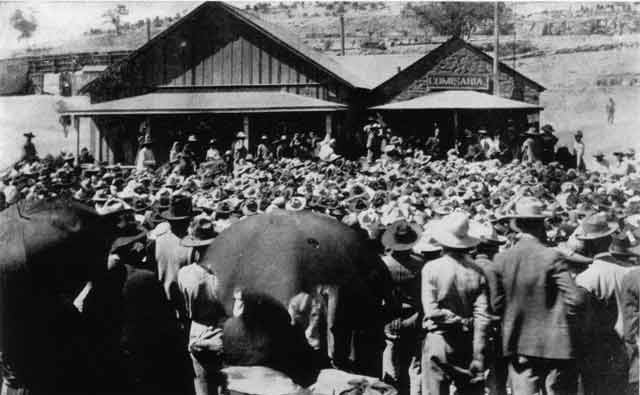
Cananea miners gathered in front of the police station as boss Greene fruitlessly tries to convince them
to return to work. Strike was joint effort of Mexican and U.S. workers. Photo:Fondo de Cultura Económica)
The following article is translated
from a supplement to El
Internacionalista published by our comrades of the Grupo
Internacionalista
in Mexico and distributed to miners in Cananea along with the
accompanying
article, “Mexican
Miners Strike for Safety, Against Anti-Worker Attacks.”
June 1, 2006 marked the
centenary of the copper mine strike at Cananea, in the northern Mexican
state
of Sonora (about 50 miles southwest of Douglas, Arizona). The
conglomerate that
now operates the mines, Grupo México, decided to celebrate the
event in its
usual way: it tried to prevent the commemoration by ordering the
workers to
carry out their usual tasks. Against this flagrant attack – a blatant
violation
of the collective contract, which designates the anniversary as a
holiday – the
militant miners of Latin America’s largest copper mine went on
strike. For almost
50 days, the miners of Cananea fought shoulder to shoulder with their
fellow
Sonoran workers in the mines of La Caridad, in Nacozari (roughly 55
miles
southeast of Cananea) and La Calera in Agua Prieta, Douglas’ neighbor
just
across the U.S.-Mexico border, and with the steel workers at the
SICARTSA-Las
Truchas mill in Lázaro Cárdenas, on the Pacific coast of
Michoacán state. There
two strikers were cut down by enemy fire in a pitched battle that threw
back a
military/police attempt to break the workers’ occupation of the biggest
steel
works in Latin America.
The SICARTSA steelworkers
won a resounding victory, with an 8 percent wage increase with back
pay, and
withdrawal of all charges against the strikers. The Cananea miners, on
the
other hand, abandoned by their national “union,” had to return to work
empty-handed. The very same National Union of Miners, Metalworkers and
Allied
Trades of the Mexican Republic (SNTMMSRM, by its Spanish initials),
even though
it was under government attack, stood by the laws of Mexico’s
corporatist labor
system. The SNTMMSRM threw in the towel when the Federal Arbitration
and
Mediation Board (JFCyA) rescinded its contract with Grupo
México. The
battle-hardened miners were forced to take down their red and black
strike
banners (the traditional symbol for a strike in Mexico) for one simple
reason: the
lack of a revolutionary class-struggle leadership. But today, in
2007, once
again the militant miners of Section 65 have not buckled after more
than 130
days on strike.
After the death of 65 coal
miners, buried alive at Pasta de Conchos in the state of Coahuila,
about 110
miles north-west of Laredo, Texas in February 2006, there was an
avalanche of
comparisons between the current conditions in the mines and those that
prevailed 100 years ago in Cananea (see “Asesinato capitalista en Pasta
de Conchos”, El Internacionalista/Edición México
No. 2,
August 2006). A century
later, the bosses’ abuse of the workers is as brutal as ever. At the
dawn of
the 20th century, the dishonest official statistics indicated mining as
the
riskiest job in Mexico. Today it remains the most dangerous of the 121
official
industrial classifications. The miners of Pasta de Conchos were victims
of
criminal neglect of the most elemental safety standards by the
management (the
same Grupo México) and by the state and federal governments, who
relied on the
complicity of the mine workers’ “union.”
It’s not just the terrible
working conditions in the mines that continue to claim workers’ lives.
As they
have for the past century, the ruling class opts for the “peace of the
grave.”
While in 2006 the government of Ulises Ruiz Ortiz and the Institutional
Revolutionary Party (PRI) in Oaxaca attacked striking teachers,
accusing them
of endangering the education of the children, resulting in the murder
of over
20 supporters of the Popular Assembly of the Peoples of Oaxaca (APPO),
at the
same time the PRI governor of Sonora, Eduardo Bours, closed Cananea’s
schools
in an attempt to pressure the miners by denying their children
schooling.
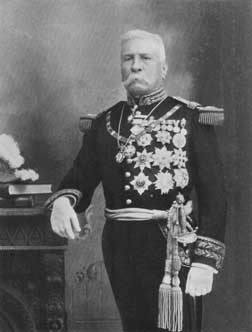 José de la Cruz
Porfirio Diaz, the dictator who launched industrialization and opened
Mexico to foreign capital. Cananea strike was one of key events that
led to his overthrow in 1910, after almost 40 years in power.
José de la Cruz
Porfirio Diaz, the dictator who launched industrialization and opened
Mexico to foreign capital. Cananea strike was one of key events that
led to his overthrow in 1910, after almost 40 years in power.
Much has been written about
the saga of the Cananea miners in 1906. Along with the textile workers
strike at
Río Blanco of 1907, it has been incorporated into the liturgy of
the rebellion
against the dictatorship of Porfirio Díaz1.
The schoolbooks describe these struggles as precursors of the Mexican
revolution of 1910-1917. Esteban Baca Calderón and Manuel
Diéguez, whom the
official history has raised up as the heroes of the miners’ cause, have
taken
their places in the iconography of the Revolution. The battle cry,
“Five pesos
and eight hours of work, ¡viva México!” that was
hurled at the offices
of the U.S. company that owned the mine at the time has become famous
as the
succinct expression of the revolution’s democratic nationalist program.
However, the miners of Cananea marched under red banners, and
contrary
to their petty-bourgeois ostensible spokesmen Baca Calderón and
Diéguez, the
true leaders of the mine workers were revolutionary syndicalists
from the
U.S. and Mexico who fought for international workers revolution.
Origin and Development
of
the 1906 Strike
As the historian Javier
Torres Parés notes in his book La revolución sin
frontera (UNAM, 1990),
“As it developed, the workers movement in Mexico established many links
with
the U.S. proletariat.” So much that “in the border areas ... they
managed to
build a single zone of workers mobilization.” At the beginning of the
20th century,
about half a million Mexicans lived in the U.S. southwest, where they
made up
the bulk of the railroad maintenance workers, coal and copper miners,
and
agricultural laborers. Torres Parés highlights the influence
that the socialists,
anarchists and revolutionary syndicalists of the Industrial Workers of
the
World (IWW) in the U.S. had on the Mexican Liberal Party (PLM). The
principal
leaders of this party, the brothers Ricardo and Enrique Flores
Magón, were in
exile in the United States, and maintained contact from St. Louis
particularly
with the leaders of the PLM in Cananea. In the mines, workers from the
U.S.,
many of whom sympathized with the IWW, made up a third of the 7,500
employees
of the Cananea Central Copper Company (CCCC). Already in 1902, ’03 and
’04,
skilled workers from the U.S. had launched a number of strikes in
Cananea.
Various liberal and
“progressive” journalists have noted certain similarities between the
events of
1906 and the miners’ struggles today. On the day after the massacre at
SICARTSA, Luis Hernández Navarro published an article, “Cananea,
once again” (La
Jornada, 21 April 2006). The columnist Miguel Ángel Granados
Chapa, for his
part, wrote: “The poor working conditions in the Cananea, Sonora copper
mine
produced, on 1 June 1906, a strike that was put down by fire and sword.
Today
the union struggle there challenges the government over trade-union
autonomy” (Reforma,
1 June 2006). Granados Chapa recalls the discrimination against Mexican
miners,
their exclusion from the better paying jobs, and how they were paid in
Mexican
pesos when almost all their expenses were in dollars, since Cananea
depended on
goods imported from Naco, Arizona. These facts led various radicals to
perceive
the “revolutionary potential of the miners’ unionism,” as Granados
Chapa puts
it, which is why the PLM led the brothers Flores Magón and
“various U.S.
radical groups” sent delegates to the region.
Among the miners there was
a particularly deep resentment of the arbitrary discipline they endured
from
the supervisors, which reflected the paternalist regime of the
company’s owner,
“Colonel” William C. Greene, a small-time Wall Street stock manipulator
who
made himself into a “copper baron” and who ruled the mining town as his
personal
fiefdom. Greene had built a Yankee enclave in the Sonoran desert: in
seven
years he not only acquired the mining rights, but took hold of the
local
economy with his company stores and the refining plant that he built,
as well
as the rail lines he controlled linking Cananea with Naco and Nogales
in
Arizona.
The traditional nationalist
interpretation of the Cananea strike is based, in large part, on the
memoir of
Esteban Barca Calderón, Study of the Yaqui War and Genesis
of the Strike at
Cananea (1980)2.
He
especially denounces the “racial hegemony throughout the company, on
our own
native soil, at the cost of our national interests, to the detriment of
the
Mexican worker and national pride and of the most elementary principles
of
justice and national rights.”
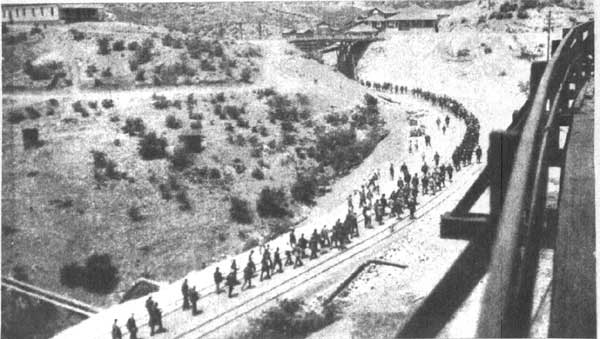
Miners marching on company offices to
present list of demands on 1 June 1906.
(Photo: Agustin Victor Casasola)
The justified hatred of the
racist treatment of and systematic discrimination against Mexican
workers by
the U.S. owner did play an important part in the strike. However, there
were
other factors that fed the revolt, such as the fear of losing their
jobs as a
result of mining concessions to independent contractors, and opposition
to the
Díaz dictatorship. Barca Calderón, who would later become
an officer in
Francisco Madero’s anti-reelectionist army3
and ended his life as a PRI senator, was a petty-bourgeois intellectual
who had
recently arrived in the area. There he met up with Manuel
Diéguez, a local
merchant. This pair petitioned to local authorities against the CCCC’s
trampling on “free trade.” The workers had other concerns, and although
the bosses
and their men treated all Mexicans like peons, the Mexican miners did
not see
all U.S.-born employees of the company as identical. Their class hatred
for the
abusive foremen mixed with their resentment over their national
oppression.
Nevertheless, they found strong allies among the U.S. miners with whom
they
worked in crews.
There are many sources on
the outbreak of the strike. Adolfo Gilly, in his book The Mexican
Revolution
(The New Press, 2006), relates how the miners “went out on strike
demanding the
removal of an overseer, a minimum wage of five pesos for eight
hours
work, respectful treatment, and that all positions be filled, given
equal
abilities, by 75 percent Mexicans and 25 percent foreigners. They put
forward
their demands in a manifesto in which they attacked the dictatorial
government
as an ally of the foreign bosses.” The development of the strike itself
and the
repression that followed is well known in its broad outlines. The
anthology
edited by Eugenia Meyer, La lucha obrera en Canaea 1906
(Instituto
Nacional de Antropología e Historia, 1980) gives a detailed
exposition of the
official version of the events.
According to this version,
the struggle was set off by the announcement on 31 May 1906 in the
Oversight
mine that the workforce would be cut and the workload for each miner
increased.
On the early morning hours of 1 June, the workers gathered in front of
the mine
offices and declared their strike over these issues. They sent for
Diéguez and
Baca Calderón to be their spokesmen to the company. Two thousand
miners marched
through the mines, workshops, foundry and refinery, joining the
movement en
masse. During the afternoon of June 1, the miners’ protest passed by
the
offices of the CCCC and commercial emporium, and proceeded to march
behind a
Mexican flag and a number of red flags on the lumber yard. There they
were
repelled by high pressure fire hoses and rifle shots, which killed one
worker.
Infuriated, the strikers set fire to the lumber yard, where two North
American
supervisors died.
When protesters returned to
the city hall, boss Greene tried to convince them to return to work,
but they
paid him no heed. Company men, particularly the Americans, opened fire
on the
crowd. From the roof of a hotel, marksmen shot indiscriminately at the
miners,
killing several. According to reports in the Tucson Citizen and
the Douglas
Daily Dispatch, “One of the leaders, who, according to all
eyewitness
accounts, carried a red flag, continued to incite the Mexicans....
[S]ome of
the more excited Americans opened fire and a general fusillade
resulted. The
flag-waving leader was hit by at least fifteen bullets” (from Herbert
O.
Brayer, “The Cananea Incident,” New Mexico Historical Review,
October
1938). Gunfire continued through the evening and all night, resulting
in over
20 Mexican workers dead.
Meanwhile, boss Greene
telegraphed the state governor, Rafael Izábal, requesting that
he come to
Cananea himself and send troops. Since the troops could not arrive for
two days
due to lack of a direct route, Greene also asked Washington and the
state of
Arizona for help. Some 275 Arizona Rangers were dispatched from the
mining
center of Bisbee, crossing the border at Naco early on June 2, where
the
Sonoran governor Izábal swore them in as “volunteers.” Their
commander, Captain
Rynning, was given the same rank as an officer in the Mexican army.
The American militia
arrived in Cananea by train later that morning, where Izábal
harangued the
rebellious miners, rejecting a wage increase and equal pay for Mexican
and U.S.
workers. Among his arguments, he mentioned that American prostitutes
cost more
than their Mexican counterparts. In fact, the government of Porfirio
Díaz had
decreed a maximum wage law. At the same time, Governor
Izábal threatened
to send all recalcitrant strikers to fight in the genocidal war he was
waging
against the Yaqui Indians. When speakers for the workers responded,
they were
imprisoned on the spot together with the strike leaders. That afternoon
the
paramilitary rural police, the rurales,
arrived and the Rangers withdrew. The next day a platoon of
100 Mexican Army soldiers arrived. The town was placed under military
occupation.
At one point there were up
to 100 miners in the Cananea jail. A number of the leaders were
prosecuted by
Izábal’s odious government and sentenced to 15 years in prison
at the notorious
island fortress of San Juan de Ulúa in Veracruz harbor. They
were only released
in 1911 after the fall of the Díaz regime. These events were
intimately linked
with the fate of Díaz’s regime, the development of international
capitalism and
the first imperialist world war. One month later, on 1 July 1906, the
Liberal
Party launched its platform, written by Ricardo Flores Magón, in
which he
called for an eight-hour working day, a wage increase to cover the
necessities
of life and an end to racial discrimination, demands which clearly
reflected
the struggle in Cananea. In 1907, the mine was temporarily closed due
to the
financial crash on Wall Street and the recession that followed in the
U.S.
Despite regaining his control over Cananea with the suppression of the
previous
year’s strike, Greene lost the mines to the great Anaconda Copper
Company. Also
in 1907 revolutionary workers struggles broke out in Río Blanco
and Orizaba,
Veracruz, led by militant supporters of the PLM, and in 1910 the
Mexican
Revolution began.
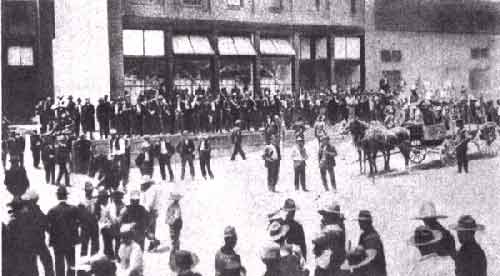
Armed Americans protect offices of Cananea
copper company, June 1906
Who Led the Strike at
Cananea?
In the literature on the
Cananea strike, while reproducing the same nationalist version of
events,
various authors do reveal a certain awareness of the presence of
different
political currents that influenced the struggle. Thus the historians’
collective at the National Institute of Anthropology and History (INAH)
remarks
about the two PLM clubs in the area: “Although their leaders ... did
not come
from the working class but were small businessmen, intellectuals and
white
collar workers, they were recognized as leaders of the workers when the
strike
broke out” (La lucha obrera en Cananea
1906). However, their account leaves aside the considerable international influence of
anarcho-syndicalism on the struggle. In fact, the formation of a second
nucleus
of the PLM in Cananea was due to certain differences between the local
partisans of magonismo. While the Union of Liberal Humanity
(Unión Liberal
Humanidad) led by Baca Calderón and Diéguez set itself
the task of organizing a
Miners Union of the United States of Mexico, they only managed to unite
a few
of the better-paid workers in Cananea. On the other hand, the Cananea
Liberal
Club (Club Liberal de Cananea) spread its influence in the mines of El
Ronquillo
and Mesa Grande.
This second club was led by
the lawyer Lázaro Gutiérrez de Lara and by Enrique
Bermúdez, who served as the
link with the PLM in St. Louis, Missouri and with the Western
Federation of
Miners in Douglas, Arizona. At that time the WFM followed a
revolutionary-syndicalist political line. Bermúdez had come to
the area in
November 1905 as a representative of the newspaper Regeneración
and got in touch with Baca Calderón and Diéguez. After
the celebration of Cinco de Mayo organized by the magonistas,
at which Gutiérrez Lara was the principal speaker, agitation
among the workers increased to the point that “a good number of the
U.S.
workers, besides sympathizing with the WFM, also agreed with the ideas
of the magonista militants” as Salvador
Hernández notes in his chapter, “Libertarian Times. Magonismo in
Mexico:
Cananea, Río Blanco and Baja California” in Volume 6 of the
series edited by
Pablo Gómez Casanova, La clase obrera en
la historia de México (Siglo XXI Editores, 1980). Police
surveillance of
Gutiérrez and Bermúdez was also stepped up.
From the reports of the
police spies it is clear that the principal leaders of the workers’
struggle in
Cananea were Gutiérrez Lara and Bermúdez, and that the
two had gone about
preparing for the strike at meetings “on Wednesday and Friday evenings”
throughout the entire month of May. Two days before the strike broke
out, the
manager of the mine got in touch with the colonel in command of the
treasury
police to warn about “the intention to ‘organize’ the company’s Mexican
workers
for the purpose of calling a strike for the same wages as the U.S.
workers” and
also with the political goal of “gaining control of the government.”
According
to Greene, he was given timely information by a fink that “that a
socialist
club had held three meetings at midnight on May 30 at midnight, at
which a
large jumber of agitators of socialistic tendencies were present; that
agitators of the Western Federation had been through the mines inciting
the Mexicans
and they had been furnishing money for the socialistic club at Cananea.
He also
gave us a couple of copies of the revolutionary circulars that had been
widely
distributed” (cited by Brayer in “The Cananea Incident”).
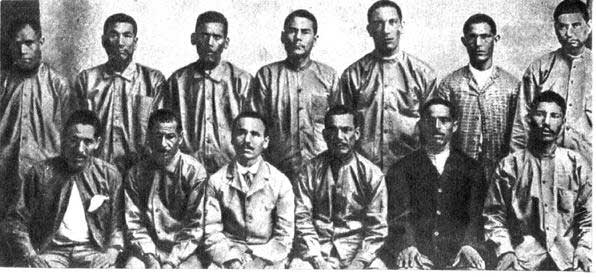
Some of the
Cananea miners arrested for participating in 1906 strike. (Photo:
Agustin Victor Casasola)
These facts alone refute
the validity of Baca Calderón’s version, according to which the
movement had
been “spontaneous.” So, asks Salvador Hernández, “Why this
distortion of the
facts, if Baca Calderón really was one of the workers’ leaders
present at the
meeting” that decided on the strike? It turns out that the decision
taken at
that meeting “caused a deep division among the members of the two main
workers
organizations in Cananea, over the methods of struggle to be followed
throughout the strike.” The group around Baca Calderón and
Diéguez, the Union
of Liberal Humanity, looked toward negotiation with the company and the
government,
which the others roundly rejected. Moreover, Diéguez “was
visibly upset,
condemning the movement.” On the morning the strike began, when the
workers
went to wake him, he didn’t want to go to management on behalf of the
strikers.
When Greene’s refusal to raise wages was received, “He told [the
workers] that
nothing had been gained. Having done this, Diéguez and
Calderón disassociated
themselves from the movement and withdrew to their homes.”
“For their part, the group
led by Gutiérrez de Lara, Enrique Bermúdez and a few
activists from the Western
Federation of Miners had opted for the road of direct action”, writes
the historian
Hernández. He cites an array of newspapers from the U.S. border
towns that put
the “blame” for the strike on the revolutionary agitators. “The problem
that
started the riot was prepared ... by incendiary speeches given by
members of
Mexican socialist organizations,” wrote the Tucson
Citizen of 2 June 1902, adding that “American socialist agitators
had come
to Cananea months in advance in order to propagate their doctrines
among the
Mexicans and spur them to the formation of miners’ unions.”*
The Douglas Daily Dispatch of 7 June
1902 reported, “With the arrival in Cananea some months back of Lara
and
Bermúdez, the current conflict began. These two men, by means of
revolutionary-spirited newspapers, began propounding the need to bring
down
Díaz’s government... and quietly began to organize revolutionary
workers’
clubs.”*
It is notable that in the
internal correspondence of the CCCC (cited in the book of Manuel
González
Ramírez, La huelga de Cananea [Fondo
de Cultúra Económica, 1956]), in a list of “agitators,”
who went about the
mines creating disturbances, nine Mexican workers are named and five
North
Americans (named Cunneham, Moore, Walsh, Woods and Kelley). In the
repression
that followed the defeat of the strike, both Gutiérrez de Lara
and Bermúdez
managed to escape to the U.S., where they were protected by their
comrades of
the IWW and the WFM. For their part, Diéguez and Baca
Calderón, in spite of
their decision to stay at home, and even though they thought “the
strike was
doomed to fail,” were sent to prison and later erroneously praised as
the
principal leaders of the strike. Calderón himself wrote that the
protagonists
of the action were “revolutionary groups that pursued ends of a
general,
national character” (Génesis de la huelga
de Cananea).
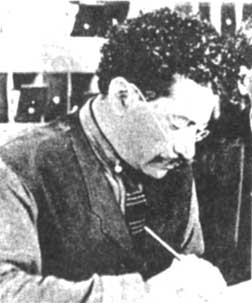 Ricardo Flores
Magón
Ricardo Flores
Magón
For the
revolutionaries who
in fact organized the strike, one cannot simply say that the strike was
a
disaster, despite its violent suppression. Ricardo Flores Magón
considered the
strike at Cananea an integral part of his plans for a social
revolution, which
were expressed in the program of the PLM, promulgated one month after
the
events of Cananea. However, the PLM was very far from being a party of
the
working class, much less of the proletarian vanguard. While the Flores
Magón
brothers did evolve toward anarchism, the roots of their party are to
be found
in Benito Juárez
and his 1857
Constitution, not in Marx or Bakunin. As Manuel González
Ramírez wrote in his
introductory note to the compilation of materials La
huelga de Cananea: “In their struggle, the liberal opponents of
General Díaz saw themselves as heirs to 19th century Mexican
liberalism. They
continuously put forward the paradigms of Benito Juárez4,
Ignacio
Ramírez5,
Melchor Ocampo6
and
Sebastián Lerdo de Tejada7.”
Revolutionary syndicalists
on both sides of the border were inspired by the Cananea uprising,
along with a
whole series of struggles led by the IWW “wobblies” and the WFM miners
in those
years. In 1911 and afterwards, as Torres Parés notes, they gave
rise to a
“mobilization with a clearly anti-imperialist tint that the workers of
both
countries waged against U.S. government intervention in Mexico.” The
1906
strike at Cananea was also a precursor of the copper miners’ strike of
1917 in
Bisbee, Arizona, that ended with the arrest and deportation of hundreds
of Mexican
miners (see “Bisbee, Arizona Deportation of 1917: ‘Reds’ and
Immigrants,” The Internationalist No. 2, April-May
1997). Nevertheless, the strikes of both Cananea and Bisbee
demonstrated the
inability of the doctrines of revolutionary syndicalism to complete the
longed-for
workers revolution.
To bring down the rule of
capital requires much more than for the workers to stop working. It
demands
that the most advanced elements of the working class place themselves
at the
head of all the oppressed, including the poor peasants and indigenous
peoples,
to prepare a general uprising that affects the bourgeois army, the
backbone of
the capitalist state. The active seizure of power must be prepared in
order to
build a workers state that can crush bourgeois reaction and open the
way to
socialism. The definitive act of a revolution is an insurrection, not a
general
strike. And for this a key element was missing, in 1906 as in
1910-1917: the
existence of a communist party of the working class vanguard, capable
of
carrying out the necessary preparations for victory that the militant
miners of
Mexico and the U.S. lacked. Without such a party, the Mexican working
class
will continue to be, in the famous phrase of José Revueltas, “a
headless
proletariat.”8
A Century of Workers
Struggle in the Sonora Desert
The workers struggle in
Cananea did not end at the beginning of the 20th century. Far from it.
As the
largest copper mine in Latin America and one of the ten largest in the
world,
the first industrial union was organized at Cananea in the 1930s, the
Grand
Workers Union of the Martyrs of 1906, which later became Section 65 of
the
SNTMMSRM. In 1971, the Mexican government bought up the majority of the
shares
of the Anaconda Copper Company and completed the nationalization of the
mine in
1982. With the investment of some $900 million to modernize its
physical plant,
Cananea greatly increased its output and became one of the most
important companies
in the country. Nevertheless, when the government of Carlos Salinas de
Gotari
decreed the privatization of over 1,000 state-owned enterprises, the
Cananea
mine was given to the Nafinsa development bank for reorganization (that
is,
reducing its workforce) to make it “more attractive” to buyers. In the
summer
of 1989, the management announced plans for closing two departments,
spinning
off other divisions to create new firms with new (and worse) labor
contracts,
and the firing of hundreds of the 4,000 workers.
The new companies were to
work 365 days per year, overriding the contracts that gave workers
Sundays and
holidays off. Section 65 went on strike. A week before the strike
began, the
mine was declared insolvent due to inability to pay its debts. But
around 80
percent of these were fictitious charges supposedly owed to Nafinsa. On
the
same day, thousands of Mexican army soldiers arrived in Cananea, who
proceeded
to pull 600 workers off the night shift, and barred 1,000 day shift
workers
from entering. Helicopters hovered over the city and troops patrolled
the
streets. The head of the SNTMMSRM, the corporatist “union” that was
part of the
PRI-government apparatus, asked for an audience with president Salinas
to
negotiate the matter.
But a rebellion was brewing
among the miners of Cananea. A resolution of Section 65 demanded the
withdrawal
of troops and the Federal Judicial Police, who were investigating the
union
“over the false impression that we had an arsenal and guerrilla groups.
We
don’t believe in the government or the PRI,” declared the motion. The
U.S.
expert on Mexican trade unions, Dan La Botz writes in his book, Mask of Democracy: Labor Suppression in
México Today (South End Press, 1992):
“Gómez Sada
declared that
the workers were not responsible for the bankruptcy of the company, but
took no
action to defend union members except to demand that they be severed as
provided by the contract and the labor law.”
Gómez Sada wasn’t alone in
abandoning the members of his own “union.” Neither the Confederation of
Mexican
Workers (CTM) nor the Congress of Labor (CT), the principal corporatist
labor
confederations, did a thing for them. The boss of the CTM and the CT,
Fidel
Velásquez, later said that he did not show any support for the
strike because
the SNTMMSRM opposed it (Andrea Becerril, “Impide Gómez Sada el
apoyo del CT a
obreros de Cananea”, La Jornada, 7
September 1989, cited in La Botz). The Mexican workers were dumbfounded
by the
utter capitulation of “their” unions.
After four days, the army
withdrew from the city. Even then, Gómez Sada insisted that
nothing could be
done, because everything had been done in accord with the labor law in
force.
The executive boards of Union Federation of Government Service Workers
(FSTSE)
and the Revolutionary Confederation of Workers and Peasants (CROC), an
alternative corporatist labor federation, expressed their
“understanding” for
the government’s actions. Despite the corporatist bureaucracy’s refusal
to take
up the least action in its defense, the miners of Section 65 went ahead
with
their strike plans. On 28 August 1989 they walked out, and on September
1 independent
unions demonstrated in the capitol in support of the workers of
Cananea. The
Labor Department proposed to withdraw the bankruptcy judgment in
exchange for
eliminating 115 clauses of the contract and amending 143 others,
definitive
proof of the spurious nature of the “bankruptcy.” A few days later, the
JFCyA
approved the company’s petition to void the contract in its entirety.
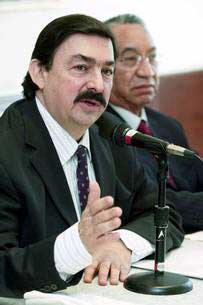 Napoleón
Gómez Urrutia,
leader of SNTMMSRM, fell afoul of PAN governments, whereupon he was
removed and criminal charges brought. Class-conscious workers demand
all charges be dropped while fighting in corporatist “unions” to form workers committees free of any
state control.
Napoleón
Gómez Urrutia,
leader of SNTMMSRM, fell afoul of PAN governments, whereupon he was
removed and criminal charges brought. Class-conscious workers demand
all charges be dropped while fighting in corporatist “unions” to form workers committees free of any
state control.
(Photo: El Porvenir)
Already at that time, the
differences between Section 65 and the national miners’ “union” had
come to
light, as well as the division in Cananea itself between the section’s
executive committee, which followed the directives of Gómez
Sada, and the
strike committee. The corporatist bureaucrats declared their readiness
to
accept voluntary resignations by the workers along with the severance
pay
proposed by the government. Nevertheless, the strike continued under
the direction
of the strike committee. Miners blockaded the federal highway and
occupied the
local offices of the JFCyA. Finally, the SNTMMSRM “negotiated” a new
contract
that eliminated more than150 clauses, reducing the number of job
descriptions
to three, laying off 400 workers and refusing to rehire over 700 more –
altogether
a third of the mine’s workforce – and a payment to the union in
exchange for
the layoffs. It is this payment, the famous $50 million, for which the
government is now going after the son and heir of Gómez Sada,
Napoleón Gómez Urrutia.
The reality is that from
the beginning, the government considered these funds not as a benefit
for the
laid-off workers, but as a bribe to the union for undermining the
struggle of
the Cananea miners. But like all bribes, this payoff to the corporatist
“union”
leaders for their complicity expired the moment that they demonstrated
the
slightest failure to cooperate with the regime. Thus, when Gómez
Urrutia
opposed the failed “Abascal Law” for labor reform, and then
characterized the
mine workers’ deaths in Pasta de Conchos as “industrial homicide” (a
declaration made to escape the wrath of families of the miners who
considered
the the “union” and the company “are one and the same”), the Fox
government
withdrew its support from Gómez Urrutia, accusing him of
misappropriation of
funds, and sought to impose another chief, Elías Morales
Hernández. As we explained
in our article “Asesinato capitalista en Pasta de Conchos”:
“When the regime
turns on
the ‘misbehaving child’ Gómez Urrutia to replace him with his
old rival Elías
Morales (who was second in command under Napoleón Gómez
I), it does so in order
to tighten the screws of its machinery and guarantee stricter control
over the
workers movement. Thus, it is vital for the workers to mobilize against
this
government attack and simultaneously take concrete measures to free
themselves
from all state tutelage. The workers themselves must be the ones to
smash the
corporatist apparatus by which they are tied to the capitalist state....
“In the
corporatist
‘unions’ workers committees must be formed to fight irreconcilably for
the
elimination of all state control, to break with the CT and organize
genuine
workers’ unions.”
In 1990 the mine was sold
to Grúpo México, headed by Jorge Larrea, a buddy of
president Salinas. Despite
the heavy defeat they suffered in 1989, the workers of Cananea slowly
recovered
their strength. In November of 1998 a new strike broke out, against the
company’s plans to lay off 700 of its 2,100 employees. The following
January,
the government declared the strike “nonexistent,” and threatened to
annul the
union’s legal charter. The company threatened to reopen the mine with
scab
labor. The leaders of the corporatist SNTMMSRM announced that they had
signed
an agreement to return to work, putting pressure on the local strike
leadership. But when the government representatives went back on their
offer of
an increased severance pay, the miners occupied the mine, where they
awaited
the onslaught of four Army convoys and over 300 paramilitary cops of
the Sonora
Judicial Police. Faced with the possibility of a deadly attack, they
finally
decided to abandon their occupation. Nevertheless, when they returned
to work
they found that 120 of their comrades who had been most active in the
strike
had been fired, and many others were given temporary contracts that
expired
every 28 days.
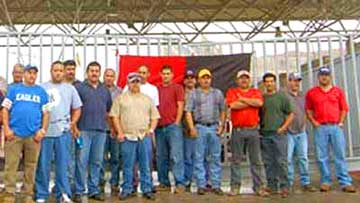 Cananea
miners with red-and-black strike
flag outside mine, December 1999. National labor leaders repeatedly
stabbed Cananea strikers in back. (Photo:
Milenio)
Cananea
miners with red-and-black strike
flag outside mine, December 1999. National labor leaders repeatedly
stabbed Cananea strikers in back. (Photo:
Milenio)
One of the most significant
aspects of the 1999 strike was the contribution from unions and copper
miners
north of the border. Shortly after the strike broke out, the strikers
sent a
delegation to Tuscon, Arizona. There, they received a warm welcome from
the
organizing office of the AFL-CIO. Although in the past the U.S. labor
federation has followed a protectionist program,
blaming Mexican workers for “stealing American jobs,” when the North
American
Free Trade Agreement (NAFTA) came into effect in 1994, the job losses
were so
great that the AFL-CIO bureaucrats occasionally have decided to help
Mexican
workers fight for better conditions. Another factor in this case were
the many
miners in Arizona with relatives working in the Sonora mines.
Nevertheless,
U.S. unionists could see that ‘”the leaders of the Mexican miners
union” were
“more loyal to the government and the PRI than to their own striking
members”
(David Bacon, “Miners’ Strike Broken in Cananea”, Z
Magazine, May 1999).
The miners of Cananea were
betrayed time and again by “their” union leaders, who in reality are
functionaries and representatives of the capitalist state. In August
2006,
after the bitter experience of that year’s strike, they demanded that
the
national “union” not participate in their wage negotiations with Grupo
México.
Today, with the corporatist system in deep decay, thus opening a crack
in the
state’s retaining wall of corporatist unions that are integrated into
the PRI
and the state apparatus, the objective conditions are present for a
successful
struggle for trade-union independence from the control of the bourgeois
state
and the bosses. But as Leon Trotsky pointed out in his work, “Trade
Unions in
the Epoch of Imperialist Decay,” the fight for union independence and
union
democracy is inseparable from the struggle for a revolutionary
leadership.
Despite their combative
spirit displayed in their strikes of 1989, 1999 and again in 2006, the
miners
have not had a leadership equal to their needs, able to simultaneously
confront
the bosses, the capitalist state and its labor cops in the corporatist
unions.
Only a class-struggle leadership, united in a communist party composed
of professional
revolutionary cadres, would be able to take on this task. This decisive
element
was the contribution of the Russian Bolsheviks under V.I. Lenin, who
together
with Leon Trotsky led the October revolution of 1917, a few months
after the
Bisbee strike. And it is exactly the recognition of the urgency need to
forge a
revolutionary leadership that is the foremost lesson of a century of
internationalist class struggle in Cananea. ■
*Retranslated from
Spanish to English.
1 A
Liberal
(anti-clerical) military officer,
and later president of Mexico (officially, by repeated reelection, or
through
puppets) from 1876 until he was forced to resign and flee to France in
1911.
2 For a quarter century beginning in the 1880s the Díaz dictatorship waged a war to put down independence struggles of the Yaqui native people who inhabited the Sonoran desert.
3 Francisco Madero, who won the 1910 election, became president of Mexico when Díaz fell to the revolution. He led the moderate bourgeois Anti-Reelectionist Party, whose Plan of St. Louis called for modest land redistribution (on idle lands) and democratic reforms. Once in power, Madero unleashed the “Constitutionalist” army inherited from Díaz against radical peasant armies led by Francisco Villa and Emiliano Zapata.
4 Benito Juárez, a liberal jurist and Zapoteco Indian, was the first indigenous head of state in the Western hemisphere, holding office from 1858 to 1872. He helped write and implemented the laws known as La Reforma, curtailing the power of the Catholic church and the military, which led to war against clerical reactionaries (1858-61) and the Emperor Maximilian (1862-67), imposed by a French invasion at the invitation of Mexican conservatives.
5 Ignacio Ramírez, author of the book There Is No God, was minister of justice and public education under Juárez during the War of La Reforma against clerical domination.
6 Melchor Ocampo was a liberal intellectual who as minister of the interior under Juárez authored the Reform Laws separating church and state.
7 Sebastián Lerdo de Tejada was foreign minister under Juárez and president of Mexico from Juárez’ death in 1872 until 1876, when he was overthrown by Porfirio Díaz. .
8 José Revueltas, the Mexican author and film writer, was expelled from the Communist Party after 15 years membership, went on to found the Liga Leninista Espartaco and later showed sympathies for Trotskyism. His Ensayo sobre un proletariado sin cabeza (written in 1960-61) is an indictment of the failure of the Stalinized Communist Party to act as the vanguard of the Mexican working class.
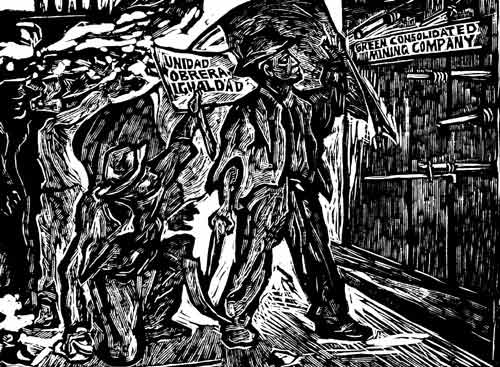
See
also: Mexico: Cananea Must Not Stand Alone!
(1 February 2008)
New York Picket Protests Repression
Against Mexican Miners (11
January 2008)
Mexican
Miners Strike for Safety (15
December 2007)
To contact the Internationalist Group and the League for the Fourth International, send e-mail to: internationalistgroup@msn.com